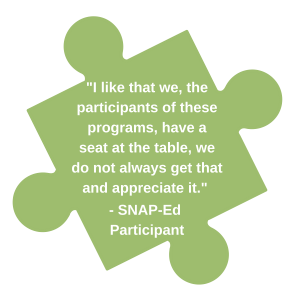Design Thinking for SNAP-Ed
Are you seeking to improve how you incorporate input from your primary audience into the development of your SNAP-Ed programming? Design thinking may help!

Design thinking is a people-centered approach to learning about a problem and developing a solution. Design thinking methods and tools are flexible, adaptable, and help organizations work collaboratively with communities and individuals who are most impacted by the identified problem.
Design thinking can help advance SNAP-Ed’s goal to “improve the likelihood that persons eligible for SNAP will make healthy food choices within a limited budget and choose physically active lifestyles” by:
- Engaging people who are SNAP-eligible in the design and adaptation of programs that center their needs and consider their barriers.
- Ensuring SNAP-Ed resources support effective and desirable programs, leading to easier recruitment and higher levels of retention.
- Reducing the amount of time and money spent on correcting implementation challenges.
- Providing tools to consider and advance equity in SNAP-Ed programs.
“How might we…”
Design thinking processes start with a “How might we…” question, which summarizes the problem or challenge you want to explore. These questions can focus on big picture challenges or technical challenges. Examples include:
- How might we conduct a needs assessment that captures our primary audience’s needs and desires in authentic ways?
- How might we encourage more participation from parents in cooking classes?
- How might we partner with grocery stores to implement healthy food retail strategies?
- How might we collaborate with stakeholders to deliver and evaluate multi-strategy interventions?
- How might we effectively pivot to online direct education delivery?
Sounds great! How can I incorporate this into my plan?
Great question! Design thinking can be integrated into SNAP-Ed plans in a variety of ways. Click the drop down arrows to learn more!
When conducting a needs assessment
When adapting interventions to expressed needs or desires
When evaluating initial implementation
In 2020, the Food, Fitness and Opportunity Research Collaborative launched Design Thinking for SNAP-Ed to explore the viability of this approach for SNAP-Ed and how it might be used to improve reach.
Through this project, we built expertise around engaging SNAP-eligible families, key stakeholders, and SNAP-Ed staff through over 60 hours of virtual sessions. We also developed tools to test user-centered intervention ideas in desirable, community-based settings.
Design Thinking for SNAP-Ed Products
 |
 |
 |
 |
Want to explore a partnership with us to implement design thinking in your SNAP-Ed Plan?
Our team can help you:
- Draft language to include in your SNAP-Ed plan to conduct design thinking activities with our guidance in the coming fiscal year;
- Design and deliver user-centered (virtual or in-person) design thinking activities with people who are SNAP-eligible and implementation stakeholders;
- Synthesize and present data and learnings from design thinking activities for local and state agencies, partners, and your primary audiences through written and visual products;
- By providing training and technical assistance to learn more about design thinking.
We can help you engage the communities you serve in new ways and build trusting relationships with partners to deliver programs. We are eager to share our tools and expertise with you as you adapt design thinking to your work!
To learn more about how we may help you use design thinking to move your work forward, email us at designforsnaped@unc.edu.
